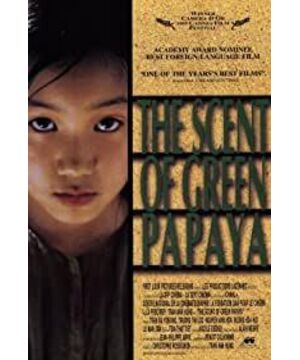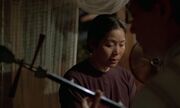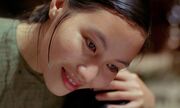Chen Yingying studied film in France and was deeply influenced by New Wave films. Watching with such an idea, it is not difficult to find that this is a movie that is good at using long lenses. The movement and zooming of the characters are used for internal scheduling of the lens, and the lateral movement of the lens is especially smooth and beautiful. However, although this is a slower-paced movie, the viewing process is not dull. Apart from the story of Mei's growth, there are several other very complete clues in the whole movie. They are related to female consciousness, and their interlacing Weaving enriches the film.
1. Awareness and Awakening of Sexuality
Mei and green papaya contacted three times. The first time was to see the white juice of green papaya dripping on the leaves, and the second time was to use green papaya as an ingredient. What happened in the process was that the little boy was peeing in the vase in front of her, which meant the awakening of sex on a physical level.
Between the second and third encounters with Green Papaya, Mei experiences seeing Ah Quan, who wears a red dress - which signifies the awakening of sexuality on a conscious level. In fact, between the first and second contact with green papaya, Mei also met Ah Quan, but at that time there was no intention to awaken sexual consciousness. This is probably because the director wanted to express women's perception of sexuality. It is physical first, then conscious, that is, Mei sees the male body first, and then develops the idea of love for the male, that is, first has an instinctive reaction, and then understands what sex is.
After the third appearance of Green Papaya, the film is nearing its end, where Mei's pregnancy means real sex.
2. Oppressed by patriarchal society
In the first half of the whole movie, which is Mei's childhood, the family is in a state of " men hurt women, women depend on each other ", the husband abandons his wife, the wife lives with her husband's mother, children, and maids; Not only that, there are many animals in the film: ants, mice, etc., observe their living conditions, it is the boy who plays with the ants with candle oil, and Mei is frightened by the mice controlled by the little boy, and breaks the vase because of the mice. In this family, the status of men is higher than that of animals, while the status of women is lower than that of animals.
A more symbolic scene is when Mei is mopping the floor, she touches the little boy's feet. The camera moves from the bottom to the top, from the feet to the face, from an upward perspective and a somewhat humble perspective.
But it doesn't mean that this kind of male power is subverted in the second half of the film——
The pursuit of love
In the family where May was a maid in her childhood, after the master left, the master's mother said to his wife, "If you knew how to love him, he wouldn't run away with other women. ", in this relationship, the part with more brush and ink is this abandoned and hurt woman, and this man is in pursuit of true love.
In the family where Mei worked as a maid after she became an adult, Mei became the role that prompted the male master to abandon his fiancee. In this relationship, it was not that no one was hurt, but the one who was not hurt was the one who was heavily penned. These are two almost the same stories. The male protagonist also loves music the same, but the focus of the story is different, so combined with the previous one, about the male-dominated society, the second half of the film is not about resistance, but only through In the second half, the animal symbols and direct oppression are omitted, so that this kind of patriarchal pressure can be naturally eliminated. These two men are in pursuit of true love, and there is another male character in this film - Uncle Ah Shuang, who is in the first generation of this three-generation story and is the oldest one. Appeared in the first half of the film, the old lady in the family who loves him, wants to see her but dares not be seen by her. He is the only male character among the three generations who has not pursued true love.
But all the male characters are active in love, and all the female characters are passive.
This is a traditional oriental female image with a little forbearance. The most commonly used composition in "The Smell of Green Papaya" is the foreground blocking, especially the frame is used as the foreground. In such oriental architecture, this blocking has more mystery, but it also seems to symbolize imprisonment.
View more about The Scent of Green Papaya reviews







